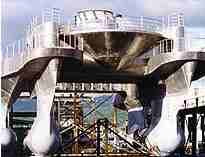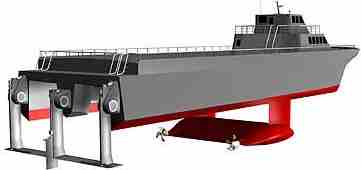|
Navatek,
Ltd. pioneered commercial SWATH
technology in the U.S., designing and building the first
commercial U.S. Coast Guard-certified SWATH (Small
Waterplane Area Twin Hull). The 16-knot, 131-foot,
430-passenger ship Navatek I was launched in
1990, marking the first advanced hull form developed by
Navatek Ltd. and earning the company its first U.S.
patent for its novel “Coke-bottle” SWATH hull form.
In
1993, Navatek, Ltd. designed the 20-knot, 85-foot,
149-passenger SWATH Navatek II, and built it in
Hawaii at Pacific Shipyards International LLC. Navatek
II incorporated canted struts developed by
Lockheed-Martin Corp. further improving the vessel's
inherently superior ride quality. Navatek I and
Navatek II entered commercial service as tour
boats in the Hawaii market.

The
SWATH hull form offers exceptional sea kindliness and
stability in a seaway, but requires excessive horsepower
to achieve high speeds. Navatek subsequently teamed with
Lockheed Martin to research and test a fast SWATH hull
form variant patented by Lockheed Martin called SLICE.
Navatek and Lockheed Martin received an Advanced
Technology Demonstration (ATD) grant from the U.S.
Office of Naval Research to design and build a 30-knot,
105-foot SLICE prototype to test the SLICE concept. The
SLICE prototype vessel was launched in November 1996.

Based
on the success of MIDFOIL,
Navatek received funding from the Office of Naval
Research to convert an existing Navy Surface Effect Ship
(SES) to a lifting body ship. Work on this $18 million
project began in 2000 and resulted in the U.S. Navy
technology demonstrator craft called HYSWAC ®. The
SES-200 provided the parent hull of the HYSWAC, reducing
project costs. During the two-year project, Navatek
removed the existing SES air lift system and all related
components, and installed a 170-ton Navatek underwater
lifting body incorporating a new propulsion drivetrain
(engines, gearboxes, shafts and propellers) within the
lifting body. This allows the craft to be operated with
variable immersion as speed increases with the parent
hull fully out of the water at maximum speed. An aft
crossfoil was also added for pitch and roll control,
along with a proprietary Navatek advanced ride control
system (ARCS).
Launched
in June 2003 at Pacific Shipyards International, the
160-foot, 30+ knot HYSWAC has a full-load displacement
of 340 LT. Sea trials of the new craft are ongoing. The
HYSWAC is designed to confirm on a large scale the three
major benefits of underwater lifting bodies verified
through CFD
studies and on the earlier, small-scale, 52-ton MIDFOIL.
|